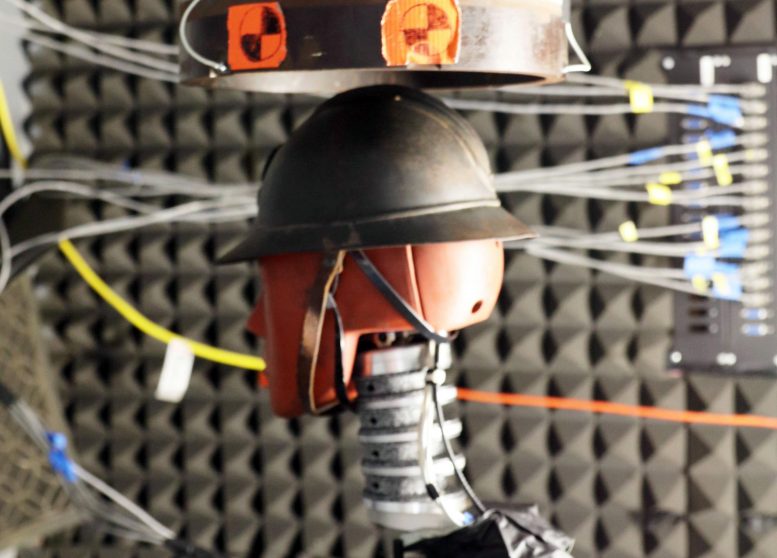
(Click image for full view.) A French helmet from World War I sits beneath a shock tube to test how well it protects the dummy underneath from a shock wave. The ridge down the center of the helmet was designed for deflecting shrapnel, but may well have also helped deflect the shock wave, allowing the helmet to outperform even modern combat helmets. Credit: Joost Op ‘t Eynde, Duke University
WWI helmets protect against shock waves just as well as modern design. French Adrian helmet suggests simple geometry may save brains from overhead blasts.
Biomedical engineers from Duke University have demonstrated that, despite significant advancements in protection from ballistics and blunt impacts, modern military helmets are no better at protecting the brain from shock waves created by nearby blasts than their World War I counterparts. And one model in particular, the French Adrian helmet, actually performed better than modern designs in protecting from overhead blasts.
The research could help improve the blast protection of future helmets through choosing different materials, layering multiple materials of different acoustic impedance, or altering their geometry.
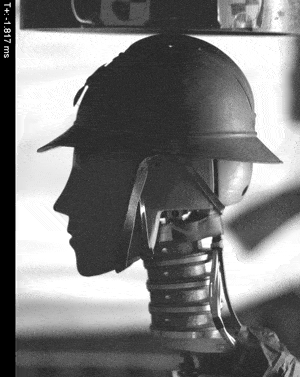
A high-speed video of a French helmet from World War I being bombarded by a shock wave designed to imitate a blast from German artillery shells a few meters away. Credit: Joost Op ‘t Eynde, Duke University
The results were published online on February 13, 2020, in the journal PLOS ONE.
“While we found that all helmets provided a substantial amount of protection against blast, we were surprised to find that the 100-year-old helmets performed just as well as modern ones,” said Joost Op ‘t Eynde, a biomedical engineering Ph.D. student at Duke and first author of the study. “Indeed, some historical helmets performed better in some respects.”
Researchers have only recently begun to study the brain damage a shock wave can cause on its own — and for good reason. Helmets were originally designed to protect from penetrating objects like bullets and shrapnel, and blast waves will kill through pulmonary trauma long before they cause even minor brain damage.
With the advent of body armor, however, soldiers’ lungs are much more protected from such blasts than they used to be. This has caused the incidence of pulmonary trauma following a blast to drop far below that of brain or spine injuries in modern military conflicts, despite the difference in blast tolerance.
While there have been studies that suggest modern helmets provide a degree of protection from shock waves, no currently deployed helmet has been specifically designed for blast protection. And because soldiers today experiencing shock waves while wearing body armor aren’t all that different from soldiers 100 years ago experiencing shock waves while in the trenches, Op ‘t Eynde decided to see if those old designs offered any lessons to be learned.
“While we found that all helmets provided a substantial amount of protection against blast, we were surprised to find that the 100-year-old helmets performed just as well as modern ones.” — Joost Op ‘t Eynde
“This study is, to the best of our knowledge, the first to assess the protective capabilities of these historical combat helmets against blasts,” said Op ‘t Eynde.
Working with Cameron “Dale” Bass, associate research professor of biomedical engineering at Duke, Op ‘t Eynde created a system to test the performance of World War I helmets from the United Kingdom/United States (Brodie), France (Adrian), Germany (Stahlhelm) and a current United States combat variant (Advanced Combat Helmet).
The researchers took turns placing different helmets on a dummy’s head outfitted with pressure sensors at various locations. They then placed the head directly underneath a shock tube, which was pressurized with helium until a membrane wall burst, releasing the gas in a shock wave. The helmets were tested with shock waves of varying strength, each corresponding to a different type of German artillery shell exploding from a distance of one to five meters away.
The amount of pressure experienced at the crown of the head was then compared to brain injury risk charts created in previous studies. While all helmets provided a five-to-tenfold reduction in risk for moderate brain bleeding, the risk for someone wearing a circa-1915 French “Adrian” helmet was less than for any of the other helmets tested, including the modern advanced combat helmet.
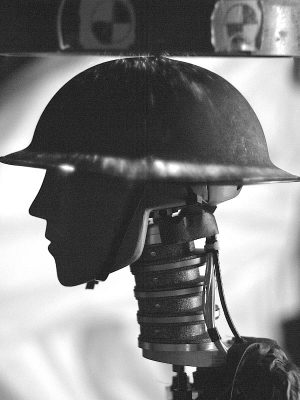
A Brodie helmet used by American and British forces in World War I is hit with a shock wave to test how well it protects the dummy underneath from primary blasts. Credit: Joost Op ‘t Eynde, Duke University
“The result is intriguing because the French helmet was manufactured using similar materials as its German and British counterparts, and even had a thinner wall,” said Op ‘t Eynde. “The main difference is that the French helmet had a crest on top of its crown. While it was designed to deflect shrapnel, this feature might also be deflecting shock waves.”
It also might be that, because the pressure sensor was mounted directly under the crest, the crest provided an additional first layer for reflecting the shock wave. And the French helmet did not show the same advantage in pressure sensors at any other location. For locations such as the ears, performance seemed to be dictated by the width of the helmet’s brim and just how much of the head it actually covered.
As for the modern helmet, Op ‘t Eynde theorizes that its layered structure might be important in its performance. Because a shock wave is reflected every time it encounters a new material with a different acoustic impedance, the layered structure of the modern helmet might contribute to its blast protection.
But no matter which helmet was tested, the results clearly indicated that helmets might play an especially important role in protecting against mild blast-induced brain trauma. According to the researchers, this finding alone shows the importance of continuing this type of research to design helmets that can better absorb shock waves from nearby overhead explosions.
“The difference a simple crest or a wider brim can make in blast protection, shows just how important this line of research could be,” said Op ‘t Eynde, who initially came to Duke on a scholarship from the Belgian American Educational Foundation, which was established with funds from American relief efforts in Belgium during World War I. “With all of the modern materials and manufacturing capabilities we possess today, we should be able to make improvements in helmet design that protects from blast waves better than helmets today or 100 years ago.”
Reference: “Primary Blast Wave Protection in Combat Helmet Design: a Historical Comparison between Present Day and World War I” by Joost Op ‘t Eynde, Allen W. Yu, Christopher P. Eckersley and Cameron R. Bass, 13 February 2020, PLOS ONE.
DOI: 10.1371/journal.pone.0228802

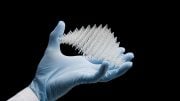
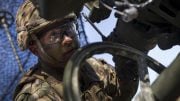

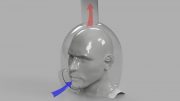

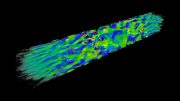
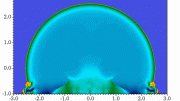

“New” is simply not necessarily better. Remember guys have been clouting each other over the head for a long time, and armorers knew a thing or two about the aftermath. Nope, they did not have plastics or ceramics, but they did know how to mass produce “protection” for the fighters. An explosive shock wave compared to being whacked by a really big guy with muscles wielding a morning star or a broadsword?
The comb on top of the french helmet is from the copy of the fire mans helmet which the makers got the contract for the military issued helmet. Soon other companies were making the military issue. The design was carried through WW2 as the helmet was a item of pride for the troops.
The famous French crested F1 fireman’s helmet (now a global standard), heir to your WWI military model, was designed in the 1970s in Gallet’s helmet museum in Chatillon-sur-Chalaronne. Most of the helmets in the museum were crested and I can remember no one even thought of not adding a crest since the rigidity and impact-dispersion advantages (firemen get a lot of heavy beams and bricks landing on their head) were well documented at least since the Franco-Prussian Bismarck war of 1870. The crest’s rigidity also allowed use of a slightly thinner+lighter metal skin. Adding crests to today’s military helmets is complicated due to fiber-composite bunching in the crest causing variable inter-layer adhesion during moulding (leading to non-reproduceability of ballistic frag-tests). Then there are the constraints posed by communications gear, ear-phones, aiming sights, eye-protection visors, mask clippability, weight, top-heaviness, ventilation, etc. Head-protection is a complex challenge of design trade-offs. Needless to say, the US Army PASGT designers were frequent visitors to Chatillon in those days. https://en.wikipedia.org/wiki/Firefighter%27s_helmet#/media/File:Pompiers_IMG_2796.JPG
Now show us an upwards blast as like stepping on a mine. Lower body damage is severe, but does a buckled helmet cause head or neck damage.
If we designed a helmet for all of the variables a combat warrior would be exposed to, it would look like a Carmen Miranda head piece. In WWI and WWII, overhead shelling was a major threat and killer of combatants, but today’s challenges don’t necessarily validate a redesign to 1917 French design standards.
We learn from the past to build for the future. Sometimes we forget the past or in the past there didn’t exist ways to test to get valid quantifiable results. When we are able to view all the results obtained through this testing we can improve a design for the future.
Which one is better at deflecting a bullet or shrapnel? That is the major concern of warriors in an armed conflict
Interesting finding for sure. But the frequency of blasts occuring above the head of soldiers on a typical modern day battlefield is exceptionally rare. It is worth noting that in a future near-peer war, the use of air burst munitions would likely increase in frequency. However, the asymmetric conflicts that are most common today involve munitions that detonate on or near ground level. Varying angles of the shock wave for this study would be required to provide a comprehensive look at what geometry should be applied to make the results relevant.
Also worth noting, a large number of helmets on a modern battlefield are adorned with accessories. For example, many militaries outfit their soldiers with night vision optics that have a mounting system on the front, and some of which run the length of the helmet over the top. There are also battery packs attached to the rear of helmets, infrared strobe lights on the top or rear, mini-flashlights and rail systems that mount to the sides, as well as integrated hearing protection ‘muffs’ that extend down and cover the ears. Consider using a fully outfitted helmet for the tests as the geometry would be significantly different with common accessories applied.
For those indicating that an “above the head” impact/explosion is more a concern of the past, or limited to airburst, you may want to think three-dimensionally. When a soldier lays prone (anytime you hear “incoming”) a blast at ground level is now “above the head.”
This is very relevant testing. Guaranteed that advances come from this research. Kudos to the engineers who decided to pursue it.
Hi,This article is so useful for me about military backpack
good job and thank you!!!
Interesting info above, regarding the various layers of kevlar disipating the shockwave. Modern tank armour works the same way.
Also, a crest could be glued to any helmet, really.